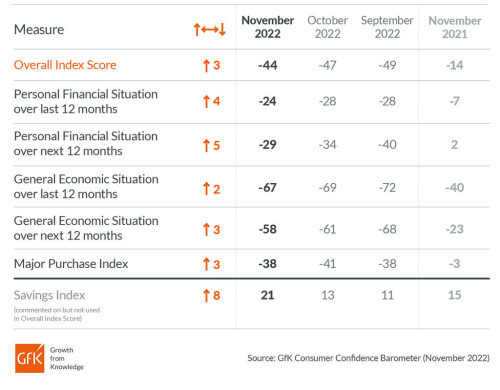Retail sales volumes in the UK grew more than expected in October, although they were still below pre-pandemic levels as surging prices took their toll.
Data published by the Office for National Statistics (ONS) shows volumes grew 0.6% last month, double the figure forecast by economists. It followed a revised down 1.5% fall in the previous month when sales were affected by the additional bank holiday for the Queen’s funeral.
However, over three months to October, sales volumes have fallen 2.4% compared with the previous quarter, reflecting the impact of the cost of living crisis.
Increases over the latest month were seen in all of the main sectors apart from food stores, where volumes fell by 1.0% and are now 4.1% below their pre-Covid levels in February 2020.
Sales volumes in non-food stores rose by 1.1% in October but were 1.7% below those recorded in February 2020.
ONS director of economic statistics Darren Morgan said: “Retail sales increased in October, although this is likely a rebound effect after weak sales last month as many retailers closed or operated differently on the extra bank holiday for the Queen’s funeral.”
He added: “Looking at the broader picture, retail sales continue their downward trend seen since summer 2021 and are below where they were pre-pandemic.”
Economists are united in expecting a continued downward trend for retail sales in the months ahead, with Pantheon Macroeconomics suggesting that October’s increase was merely a “flash dawn” led by the unwinding of the store closure impact.
Meanwhile, Richard Lim, CEO of Retail Economics, suggested that consumers had brought forward Christmas purchases to help spread the cost and manage their budgets.
He added: “The overall picture remains tough. With inflation running riot, these figures highlight that consumers are having to spend more but are getting less back in return. Retail sales volumes continue to decline sharply on the previous year as consumers are cutting back, delaying and trading down to cheaper alternatives where they can. This is clearly the case in the grocery sector with the fight to value seeing the discounters gain significant market share.”
Separate data published today by GfK showed that UK consumer confidence rose marginally to minus 44 in November from a 48-year low of minus 49 in September. All measures were up in comparison to the previous month’s reading:

However, Joe Staton, client strategy director at GfK, suggested that the uptick was likely to reflect nothing more than a “collective sigh of relief as a new prime minister takes charge following the alarming fiscal antics we saw in September.”
He added: “This is not the end of the beginning. External factors have changed little and, with UK inflation recently hitting a new high, more bad news is inevitable. Household budgets remain shrouded in massive uncertainty with fresh jumps in food prices, energy still uncomfortably expensive, the prospect of new interest rate rises pressurising mortgage and rent payments, potential future hikes in council tax and squeezed real pay.
“Consumers are looking for a festive cocktail of certainty and optimism not this mishmash of austerity and pessimism. Good news remains in short supply as many people struggle to manage the purse strings during this protracted and painful cost-of-living crisis.”
The Office for Budget Responsibility said yesterday that living standards in the UK could fall the most since records began in the 1950s in 2022/23. The fiscal watchdog, which published its forecast alongside the Chancellor’s Autumn Statement, calculated that over the next two years, the household disposable income will wipe out the previous eight years of growth.




